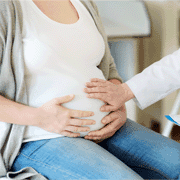Fibroid Treatment Laparoscopy - How to, Cost & Everything to Know
In This Article
Fibroid Treatment Laparoscopy - How to, Cost & Everything to Know
Sidharth
Updated on December 12, 2023
Medically verified by Dr. Arya
Fact checked by Dr. Sharon

Laparoscopic
9 min read
Welcome to our guide on fibroid treatment using laparoscopy. If you're new to the world of fibroids and their treatment, you're in the right place. We'll break it down for you, just like a doctor would.
What are Fibroids?
Uterine fibroids are non-cancerous growths that can develop in the uterus (womb). They can vary in size, ranging from as small as a seed to as large as a grapefruit.
Fibroids are quite common and can appear in different parts of the uterus: within its walls, on its outer surface, or even inside the uterine cavity.
The characteristics of fibroids can vary. Some women may have only one fibroid, while others might have several. They can be smooth or have a more textured surface, and their growth patterns can differ as well.
Depending on their location and size, fibroids can cause a variety of symptoms, such as:
- Heavy menstrual bleeding
- Pain in the lower back
- Pressure on the bladder or bowel
- In some cases, even fertility issues
While fibroids are typically non-cancerous, they can still impact a woman's health and quality of life. If you suspect you have fibroids, it's recommended to consult a healthcare provider for proper diagnosis and guidance on the best treatment approach.
Who is at Risk of Having Fibroids?
Let's talk about who might have a higher chance of getting fibroids. Women in their 30s to 50s are more likely to develop fibroids. This is because of the changes in hormones that happen during this time.
Family history also plays a role. If your mom, sister, or other close family members have had fibroids, it could increase your chances of having them too.
Ethnicity can contribute to risk too. Studies have shown that African-Caribbean women are more likely to develop fibroids. They might experience them at a younger age and in larger sizes compared to women of other ethnic backgrounds.
Hormonal factors, such as having high levels of oestrogen, can also contribute. Hormones, like oestrogen, play a role too. If your body has a lot of oestrogen, it can lead to fibroid growth.
Being overweight and having certain eating habits might also contribute. A diet high in red meat and low in fruits and vegetables, might increase your risk.
Remember, these factors can make fibroids more likely, but they can happen to anyone. If you're worried or having symptoms, it's best to talk to a doctor about it.
Types of Fibroids
There are different types of fibroids, each with its own characteristics. Here's a breakdown of the main types:
Intramural Fibroids: These are the most common. They appear inside the muscular wall of the uterus. As they grow, they can make your uterus stretch.
Subserosal Fibroids: These form on the outside of your uterus, known as the serosa. Sometimes, they can grow big enough to make your uterus seem larger on one side.
Pedunculated Fibroids: Subserosal fibroids can develop a stem-like base, supporting the tumour. These are called pedunculated fibroids.
Submucosal Fibroids: These grow in the middle muscle layer of your uterus, called the myometrium. They aren't as common as the other types.
Each type can bring its own set of symptoms, and your doctor will take this into account when discussing your treatment options.
Diagnosis
When it comes to diagnosing fibroids, doctors use various methods to get a clear picture of what's happening. Here are the key steps:
Ultrasound Scan One of the main tests used to find out about fibroids is an ultrasound scan. It's painless and works like this: a probe sends sound waves into your body, and these waves create pictures of what's inside you.
There are two kinds of ultrasound scans for fibroids:
- Abdominal Ultrasound: The probe is moved on the outside of your tummy
- Transvaginal Ultrasound: Here, a small probe inserted into your vagina
The images from these scans go to a screen so the doctor can see if there are any fibroids.
Hysteroscopy
For this, a small tube with a light (hysteroscope) goes into your womb through your vagina and cervix. It's a quick procedure, about 10 to 15 minutes. Sometimes you might get local or general anaesthetic, but many women don't need it. A hysteroscopy is often done to check for fibroids inside your womb.
Laparoscopy
Laparoscopy uses a small camera (laparoscope) to look inside your abdomen or pelvis. A surgeon makes a small cut in your abdomen, and the camera goes in. You'll be asleep with general anaesthesia for this procedure.
Biopsy
Sometimes, during a hysteroscopy, a tiny piece of tissue might be taken for a closer look under a microscope. This is called a biopsy. It helps doctors learn more about what's going on.
These tests help doctors figure out what's happening with your body and how to best help you.
Treatments
Let's explore the different ways to treat fibroids:
Medication Therapy
Some medications can help manage fibroid symptoms, like heavy bleeding and pain. These medicines won't remove the fibroids, but they can provide relief.
Uterine Artery Embolisation
This procedure blocks blood flow to the fibroids, causing them to shrink. It's a non-surgical option that might be helpful.
Focused Ultrasound
This treatment uses ultrasound waves to heat and destroy the fibroids. It's a non-invasive option that could be considered based on your situation.
Surgical Procedures
Now, let's talk about surgical options, where doctors physically remove the fibroids. There are different ways to do this, and one of them is through minimally invasive surgeries. These surgeries offer benefits like smaller cuts and quicker recovery compared to open surgeries.
Laparoscopic Myomectomy
This procedure focuses on removing the fibroids while keeping the uterus in place. It's a good option if you want to preserve your fertility, meaning the ability to have children in the future.
During the surgery, small incisions are made in your abdomen. Then, a camera-guided instrument helps the surgeon locate and remove the fibroids. This surgery can help ease symptoms and improve your quality of life.
Laparoscopic Hysterectomy
Hysterectomy is a surgery where your whole uterus, including any fibroids, is removed. This might be suggested if you're facing tough fibroid symptoms that aren't getting better with other treatments. But let's zoom out and consider more.
In Laparoscopic Hysterectomy, small cuts are made on your belly. Through these tiny openings, a camera and special tools are used. The surgeon watches on a screen while doing the surgery. Because the cuts are small, there's less pain, and you recover faster.
Usually, when getting a hysterectomy, women often hear about taking out their ovaries too. This is usually done to prevent ovarian cancer.
While this might sound protective, studies bring up something interesting. Women who keep their ovaries might have a lower chance of heart disease and osteoporosis compared to those who remove them.
Research hints that holding onto your ovaries, especially if you're under 65, could be good for your health. Your doctor will weigh the risks and benefits of keeping or removing you ovaires to guide you.
Exploring Other Treatment Options
Besides Laparoscopic Myomectomy and Laparoscopic Hysterectomy, let's take a look at a few more treatments that might be considered:
Hysteroscopic Myomectomy
This treatment involves removing fibroids from inside your uterus. Your surgeon will use a thin tube with a camera and tools, which goes through your vagina and cervix. The surgeon removes the fibroids without needing to make any cuts on your belly. This option would work well if your fibroids are mainly inside your uterus.
Abdominal Hysterectomy
In this approach, the surgeon makes a larger cut on your belly, similar to a traditional "open" surgery. They remove the entire uterus, including the fibroids, through this cut. This option might be chosen if your fibroids are large or if there are other health concerns.
Vaginal Hysterectomy
With this method, the uterus is taken out through your vagina. No cuts are needed on your belly. It's a possibility if your fibroids are small and your uterus isn't too enlarged.
 9 min read
9 min readTop 9 Things To Know About Laparoscopic Treatment for Pregnancy
 9 min read
9 min readHow Much Does Laparoscopy Treatment Cost? Here's The Truth
 8 min read
8 min readTreatment After Laparoscopy for Pregnancy - What You Need to Know
Book Your Consultation Now
Balancing the Pros and Cons of Laparoscopic Treatment
Now, let's take a look at what we gain and what we need to be careful about with Laparoscopic Myomectomy and Laparoscopic Hysterectomy.
What's Good:
Laparoscopic surgeries come with some great stuff. Smaller cuts mean less pain afterward. You'll recover faster and might not need to stay in the hospital for long. Also, the scars you'll have are much smaller, which can be a good thing.
| Experience | Open Surgery | Laparoscopic Surgery |
|---|---|---|
| Scars | Large | Small |
| Blood Loss | More | Less |
| Hospital Stay | 4-7 days | 1-2 days |
| Recovery | 1-2 weeks | 3-5 weeks |
What We Need to Watch Out For:
Like any surgery, there are things we have to be careful about. There could be some bleeding or infection, and sometimes, nearby organs might get hurt.
Studies have found that injuries on the bladder or uterus were more common with a total laparoscopic hysterectomy (TLH) compared to a total abdominal hysterectomy (TAH). It's really important to talk to your doctor about these things so you know what to expect.
Remember, your doctor will look at all these things and help you decide what's best for you.
Understanding the Cost of Fibroid Surgeries
Let's dive into the likely costs for different fibroid surgeries:
Hysterectomy
Abdominal or Vaginal: ₹55,000 to ₹85,000 Laparoscopic: ₹90,000 to ₹1,20,000
Myomectomy
Hysteroscopic: ₹65,000 to ₹1,00,000 Laparoscopic: ₹80,000 to ₹1,10,000
Just remember, these numbers are just a rough idea and could change based on different things. Here are a few factors that can sway the cost:
Type of Surgery: The way they do the surgery matters. If it's abdominal, vaginal, hysteroscopic, or laparoscopic, it can change the cost.
Hospital Charges: Different hospitals have different prices. The hospital you pick can affect how much you pay.
Doctor's Fees: The doctor's experience and skills can change the fees. Highly experienced doctors might ask for more.
Location: Where you have the surgery matters. Costs can be different depending on the city or area.
Medical Supplies and Equipment: The stuff they use during surgery adds up to the cost.
Also Read: laparoscopy for infertility cost in India
Fibroids are non-cancerous growths in the uterus that can cause symptoms like heavy bleeding, pain, and pressure.
Risk factors include age, family history, ethnicity, hormonal factors, and diet.
There are different types of fibroids based on location and characteristics.
Diagnosis involves ultrasound scans, hysteroscopy, laparoscopy, and biopsy.
Treatment options include medications, focused ultrasound, uterine artery embolization, and surgical procedures.
Laparoscopic myomectomy preserves fertility by removing fibroids while keeping the uterus.
Laparoscopic hysterectomy removes the entire uterus and may or may not include ovaries.
Other treatments include hysteroscopic myomectomy, abdominal hysterectomy, and vaginal hysterectomy.
Deciding on the best treatment involves considering your health, symptoms, and goals with your doctor's guidance.



